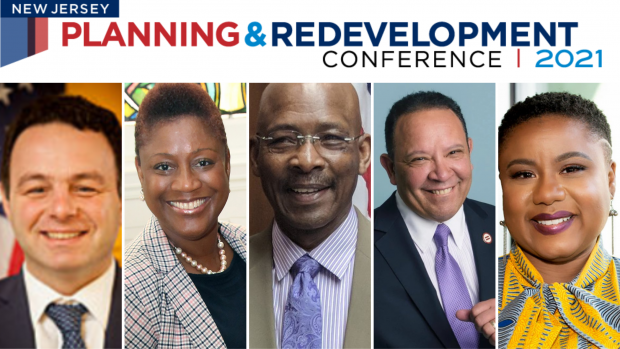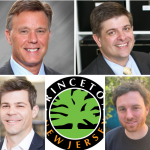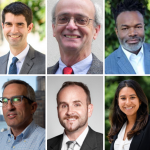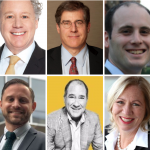New Jersey Future Blog
Municipal Approach to Racial and Economic Inclusion
June 25th, 2021 by Sherry Hicks

In a session entitled Municipal Approach to Racial and Economic Inclusion at the 2021 New Jersey Planning & Redevelopment Conference held in June and co-hosted by New Jersey Future and the New Jersey Chapter of the American Planning Association, elected officials explored what can be done to foster more racial and economic inclusion in planning and redevelopment.
Barbara George Johnson, vice president, John S. Watson Institute for Urban Policy and Research Kean University moderated the session, which included President and CEO of the National Urban League Marc Morial, and panelists Vernon Mayor Howard Burrell, Paterson Mayor Andre Sayegh, and Willingboro Mayor Tiffani Worthy.
Morial, a leading voice on the national stage for the battle for jobs, education, housing, and voting rights—and no stranger to the needs of municipalities, especially urban municipalities in New Jersey—explained that planners have immense influence and power; impacting where trees are planted, where schools are located, what street signs look like, the parameter and style and the design of houses, and how municipalities and towns think about many important and challenging issues.
“For the planning discipline—just like any of us who work on urban affairs, cities, townships, towns, villages anywhere in the United States of America—we are at that point where the challenge is how do we think about the discipline of planning through an equity lense,” stated Morial.
He urged planners to think about equity as America is reshaped demographically, such as aging Americans, changing households, and family dynamics that are moving away from what was thought of as the traditional nuclear family.
He also encouraged planners to be mindful of growing wealth inequalities, which manifest from fundamental issues of poverty and homeownership. He pointed to the Black homeownership rate being as low as it was the year the Fair Housing Act was passed in 1968.
He suggested that every community needs an affordability planning strategy and an affordable housing policy, and be insistent on their execution. “As we think about how to remake the city, we have to think about it from an affordability and a quality of life standpoint. Affordable housing strategies should include amenities, such as parks, playgrounds, broadband, and small businesses.”
Mayor Worthy shared the history of Willingboro, one of the oldest townships in New Jersey, and its economic justice challenges during its development and growth from the 1950s to the 1970s, due in large part to the development of Levittown, a community with deed-restricted racial covenants.
As a result, in the 1960s the township was sued for discriminatory practices, and in the 1970s, white flight negatively impacted the community. Today, Willingboro is a predominately Black and brown community of over 33,000 residents from all over the world.
“We have a lofty vision and have been working on updating our master plan, along with a strategic plan to attract developers to create a destination location,” she said. “We are working to overcome a lot of assumptions about our population.”
Worthy looks forward to continued partnerships with developers, residents, and elected officials at every level of government to be able to create the Willingboro we all want to experience.
Vernon Mayor Burrell shared how his experiences growing up in the Deep South prepared him for life and leadership in a predominately white, rural community in northern New Jersey.
Vernon Township is located in one of the most conservative counties in New Jersey, Sussex County. It is 85% white, 9% Hispanic, and 4% Black.
“This socio-economic makeup of my town represents its own unique challenges and opportunities to manage and neutralize any racial, economic, and political impediments,” said Burrell. “But, I can tell you this as an individual who has lived in Vernon Township for the past forty-one years, there are certain indicators that lead me to believe that we are doing OK.”
Burrell pointed to an anti-racism march organized last year by a young white resident. He also noted that over the past six months, the Covid-19 virus has driven a significant number of mostly urban residents to Vernon Township, many of which are people of color. He and the Vernon Township Council have joined together to ensure that these individuals know that their township wants and needs them to become fully included.
Paterson Mayor Sayegh shared that the city’s rich history of diversity can be traced back to it’s days as a hub for immigrants who came in waves from either South America or the American South. Founded by Alexander Hamilton, it is the third largest city in the state and the first planned industrial city in the U.S. It was recently designated the most diverse city in the state by the Star-Ledger.
“We’re proud of that designation. But we’ve had struggles,” said Sayegh, noting the challenges Paterson and other cities in the state faced in the 1960s.
Disinvestment of money and white flight to the suburbs made it hard for Patterson to recover. Sayegh pointed to what Paterson is doing today. “One of our signature economic development projects is the restoration of Hinchliffe Stadium. One of only two stadiums in the United States that hosted Negro League games,” he said. “We have affordable housing projects like the Riverside Village with 200 units set aside for senior citizens and low-income families.”
A partnership with a nonprofit organization and the local hospital will result in 56 units near the hospital with units set-aside for individuals with special needs and addressing the issue of community members using the emergency room as shelter. Additional projects include, the Guaranteed Income Initiative and the Financial Empowerment Center, and a license-restoration program launching soon to help residents get their driver’s license back and become gainfully employed.
Panelists agreed that urban revitalization needs to focus on racial and economic inclusion strategies to avoid the policies and practices of the past.
“I think in the public interest today is economic equity and inclusion and thinking through what the policy looks like, how you approach it in an intelligent, transparent way,” said Morial. “ If we can’t create in revitalization, economic participation and inclusion, then what we are doing is repeating the urban Negro removal policies of 40, 50, 60 years ago.”
Advised Morial, “A wise person changes, a fool never learns. Take the lessons and listen. Let’s do it differently, and by doing it differently, we can do it better.”
Related Posts
Tags: City of Paterson, Municipal Approach, NJPRC21, Planning and Redevelopment Conference, Vernon Township, Willingboro Township
















